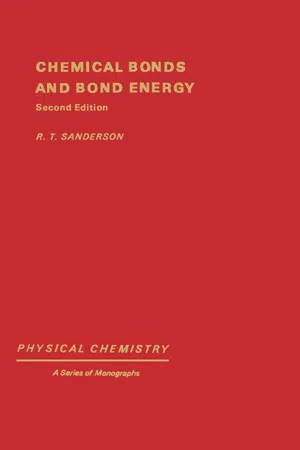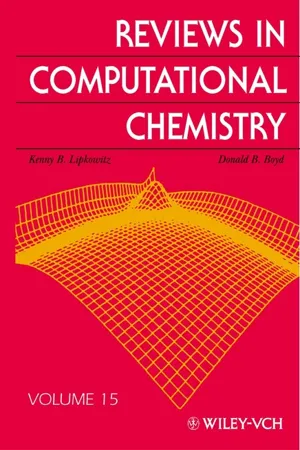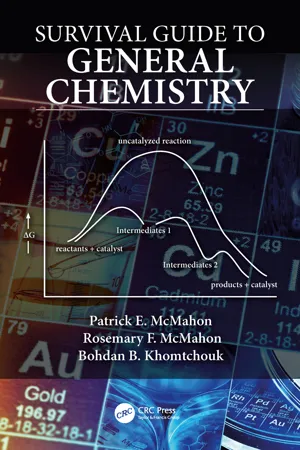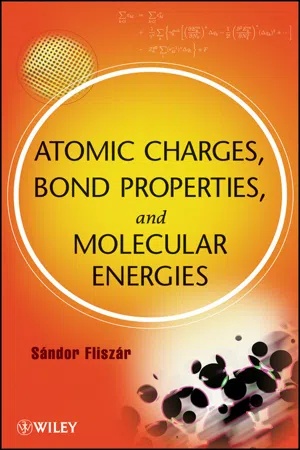Chemistry
Bond Energy Calculations
Bond energy calculations involve determining the amount of energy required to break a chemical bond. This is typically measured in kilojoules per mole (kJ/mol) and can be used to predict the stability of molecules and the energy released or absorbed during chemical reactions. By comparing the bond energies of reactants and products, it is possible to estimate the overall energy change in a reaction.
Written by Perlego with AI-assistance
Related key terms
1 of 5
6 Key excerpts on "Bond Energy Calculations"
- eBook - PDF
- R Sanderson(Author)
- 2012(Publication Date)
- Academic Press(Publisher)
SIX Polar Covalence II: The Calculation of Polar Bond Energy THE NEED FOR BOND ENERGY CALCULATION The Significance of Bond Energy All of the physical properties of matter depend on the kinds of atoms it contains and how they are arranged. All of the chemical properties of matter depend on the possibilities for atomic rearrangement. At ordinary temperatures perhaps the most important factor influencing the atomic rearrangement, which we call chemical change, is bond energy. Except for monatomic gases, all substances consist of atoms joined together primarily by chemical bonds. Atomic rearrange-ments tend to occur in the direction of formation of stronger bonds. An under-standing of chemical bonds must include a quantitative accounting of their strength through an accurate recognition of the factors which produce that strength. It is not enough to be able to evaluate bond strength experimentally. We must also be able to predict it, or to represent the true experimental value through a reasonably simple physical or conceptual model. Bond energies are vitally important in deter-mining the possibilities and, to a considerable extent, the mechanisms of chemical reactions. Nothing is closer to the heart of chemistry than bond energy. The Problem of Calculating Bond Energy Each individual atom consists of a structured arrangement of electrons and nucleus which holds together through a complex system of attractions and repul-95 96 6. Polar Covalence II sions that results in a substantially lower energy content than that of the compo-nent particles if they existed independently. To obtain by calculation the atomiza-tion energy or the bond energy of a compound, one would need to be able to know or calculate the total electronic energy of the compound and also of the individual atoms. The difference would be the total bond energy. The nature of the problem can be better understood by example. - Kenny B. Lipkowitz, Donald B. Boyd(Authors)
- 2009(Publication Date)
- Wiley-VCH(Publisher)
Bond Energy Approach The bond energy approach is typically not directly aimed at the deter- mination of standard enthalpies of formation for individual molecules although there are several exceptions.162 The bond energy technique is still worth discussing in the context of this chapter, however, since many researchers use it routinely to estimate reaction enthalpies. The energy required to break a chemical bond and separate the fragments to infinite distance in the gas phase at 0 K is commonly referred to as a bond energy. Bond energy tables using this definition cannot be used to predict en- thalpies of formation, but they may be used to predict enthalpies of reaction (at 0 K). This may be done by summing the bond energies for bonds broken and subtracting the sum of bond energies for bonds formed, being careful to ac- count for any additional energy effects such as ring strain:161 AH, = C (energy of bonds broken) - C (energy of bonds formed) [ 171 h more useful approach that deals with partial bond contributions to the gas phase enthalpy of formation at 298.15 K is that of Benson.162 Basically the bond contributions can be added together to predict either the enthalpy of formation of a molecule or the reaction enthalpy directly. A simple example of how the bond energy approach may be used is illustrated in the following trivial example. Suppose one needed to determine the reaction enthalpy for the following hypothetical reaction: Empirical Methods 191 For the purposes of an engineering design at an early stage, the reaction en- thalpy may be needed to an accuracy of only, say, k8 kcal/mol. Without resort- ing to a single bond energy table, one can predict that this reaction will be close to thermoneutral because the bonds broken and formed are so similar: Bonds Broken Bonds Formed c-0 c-Cl c-0 c-CI One may legitimately argue that the bond strengths of aliphatic and aromatic carbon bonds are different, but these differences are smaller than the desired accuracy.- eBook - ePub
- Patrick E. McMahon, Rosemary McMahon, Bohdan Khomtchouk(Authors)
- 2019(Publication Date)
- CRC Press(Publisher)
The potential energy of a (covalent) chemical bond is based on the arrangements of the bonding electrons to the nuclei of the two bonded atoms. Bonding energy is derived through the electromagnetic force of attraction between both nuclei and the bonding pair of electrons.The sum total of attractive forces for both electrons to both bonding nuclei is always greater for an electron pair in a covalent bond than for the same electrons in separated atoms. This increase in the attractive force is the basis for the strength of the covalent bond.For a chemical bond to form, the total potential energy of atoms in a covalent bond must always be less than the total potential energy of the same atoms as separated atoms.Total potential energy (PE) always decreases when a covalent bond is formed from the corresponding separated atoms. The energy released by the decrease in potential energy (−ΔPE) is converted to kinetic energy (+ ΔkE in some form).Total potential energy (PE) must always increase when a covalent bond is broken to reform the original separated atoms. The required increase in potential energy (+ ΔPE) must be supplied by kinetic energy (in some form). This means that energy must be supplied from an outside source to break a chemical bond (the outside source measures a −ΔkE).A specific potential energy associated with a specific bond, a bond PE, can be identified through the amount of potential energy decrease when the bond is formed, that is, the amount of energy released upon the formation of a specific covalent bond. This ΔPE must always be a negative value.Conversely, the amount of energy required (i.e., must be supplied) to break a specific covalent bond must be equal in value, but opposite in sign, to the amount of energy released when the bond is formed, this is termed the bond dissociation energy (B.D.E. or BDE). The value is always positive and is equal to the amount of added energy (as kE) required to break a specific covalent bond; a greater positive numerical value corresponds to a greater strength - eBook - PDF
Chemistry
Structure and Dynamics
- James N. Spencer, George M. Bodner, Lyman H. Rickard(Authors)
- 2011(Publication Date)
- Wiley(Publisher)
Chem- ical energy is the energy associated with the force of attraction between the elec- trons and the nuclei in atoms, ions, and molecules. In other words, chemical energy is the energy that is due to chemical bonds. As a general rule: Changes in energy that occur during a chemical reaction are due to the making and breaking of chemical bonds. The amount of energy associated with a chemical reaction is directly related to the strength of the chem- ical bonds that are broken and formed during that reaction. The relationship between energy and the strength of chemical bonds can be illustrated by the fol- lowing hypothetical discussion of the process by which molecules of dimethyl ether and ethanol are constructed from isolated atoms in the gas phase. Imagine a collection of isolated atoms in the gas phase consisting of 2 moles of carbon atoms, 6 moles of hydrogen atoms, and 1 mole of oxygen atoms. The atoms can be brought together to make two different molecules whose structures are consistent with the rules developed for Lewis structures described in Chapter 4. One of these molecules contains two C¬O bonds and is known as dimethyl ether (CH 3 OCH 3 ). If these atoms are brought together to make 1 mole of dimethyl ether in the gas phase, 3151 kJ of energy is released. What is the source of this energy? The energy is produced by making six C¬H bonds and two C¬O bonds per mole- cule of dimethyl ether, for a total of eight bonds for each molecule formed. This process gives off energy because energy is always released during the formation of chemical bonds. The isolated atoms in the gas phase can also be brought together to form a different compound known as ethanol or ethyl alcohol (CH 3 CH 2 OH). Each molecule of ethanol contains five C¬H bonds, one C¬C bond, one C¬O bond, and one O¬H bond for a total, once again, of eight bonds. - Sandor Fliszar(Author)
- 2008(Publication Date)
- Wiley-Interscience(Publisher)
The agreement within experimental accuracy of many predicted and exper- imental results provides an a posteriori argument for claiming that these approxi- mations are satisfactory. The internally coherent picture thus obtained provides a strong indication that the analysis of accurate ab initio computations into models, rules, properties, and interpretations meaningful to chemists should be carried out along the lines emerging from this work. 150 THE CHEMICAL BOND: THEORY (II) CHAPTER 12 BOND DISSOCIATION ENERGIES 12.1 SCOPE Consider a polyatomic molecule and focus attention on a particular atom pair, k and l, forming a bond with intrinsic energy 1 kl . This energy cannot be observed in isolation. What can be measured (in principle) is D kl , the bond dissociation energy, that is, the energy required to break up that bond. Now, D kl depends on a number of events accompanying bond breaking, including possible geometry and hybridization changes affecting the fragments. Briefly, D kl =1 kl in polyatomic molecules. 1 It is understood that D kl , like 1 kl , refers to molecules at their potential minimum. Intrinsic bond energies and bond dissociation energies meet different practical needs. The former play an important role in the description of ground-state molecules. Dissociation energies come into play when molecules undergo reactions. Now, any interaction between a molecule and its environment (such as complex formation or adsorption onto a metallic surface, for example, or hydrogen bonding) affects its electron distribution and thus the energies of its chemical bonds. If we figure out the relationship between dissociation and intrinsic bond energies, we could begin to understand how the environment of a molecule can promote or retard the Atomic Charges, Bond Properties, and Molecular Energies, by Sa ´ndor Flisza ´r Copyright # 2009 John Wiley & Sons, Inc. 1 For diatomic molecules, of course, DE a ¼ 1 kl ¼ D kl .- eBook - PDF
- William R. Robinson, Edward J. Neth, Paul Flowers, Klaus Theopold, Richard Langley(Authors)
- 2016(Publication Date)
- Openstax(Publisher)
Calorimeters are designed to minimize energy exchange between the system being studied and its surroundings. They range from simple coffee cup calorimeters used by introductory chemistry students to sophisticated bomb calorimeters used to determine the energy content of food. 9.3 Enthalpy If a chemical change is carried out at constant pressure and the only work done is caused by expansion or contraction, q for the change is called the enthalpy change with the symbol ΔH, or ΔH 298 ° for reactions occurring under standard state conditions. The value of ΔH for a reaction in one direction is equal in magnitude, but opposite in sign, to ΔH for the reaction in the opposite direction, and ΔH is directly proportional to the quantity of reactants and products. Examples of enthalpy changes include enthalpy of combustion, enthalpy of fusion, enthalpy of vaporization, and standard enthalpy of formation. The standard enthalpy of formation, ΔH f ° , is the enthalpy change accompanying the formation of 1 mole of a substance from the elements in their most stable states at 1 bar (standard state). Many of the processes are carried out at 298.15 K. If the enthalpies of formation are available for the reactants and products of a reaction, the enthalpy change can be calculated using Hess’s law: If a process can be written as the sum of several stepwise processes, the enthalpy change of the total process equals the sum of the enthalpy changes of the various steps. 9.4 Strengths of Ionic and Covalent Bonds The strength of a covalent bond is measured by its bond dissociation energy, that is, the amount of energy required to break that particular bond in a mole of molecules. Multiple bonds are stronger than single bonds between the same atoms. The enthalpy of a reaction can be estimated based on the energy input required to break bonds and the energy released when new bonds are formed.
Index pages curate the most relevant extracts from our library of academic textbooks. They’ve been created using an in-house natural language model (NLM), each adding context and meaning to key research topics.





